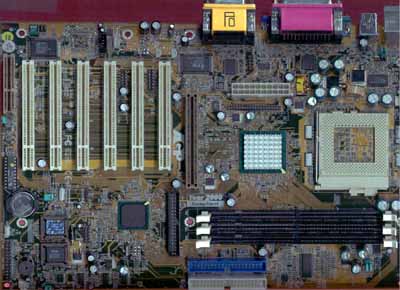Chaintech CT-6OJV2 Socket-370 i815E ATX
by Henry Kuo on October 20, 2000 1:22 AM EST- Posted in
- Motherboards
Introduction
About two years ago, Intel released the 440BX chipset for their processors running at 100MHz with everything people could possibly ask for. The 440BX was the standard by which other chipsets were measured and has survived a lot longer than originally expected. That’s because last year, Intel released the i820 chipset, which backfired severely for them. The extremely high price of RDRAM coupled with no noticeable performance gain on today’s applications simply drove people away. Intel tried to push the i820 chipset again, this time with SDRAM support, but problems with the Memory Translator Hub (MTH) forced a recall of these boards, tarnishing Intel’s reputation again. As a result, not many manufacturers actually dived into the i820 market, but rather decided to stay with the 440BX chipset a little longer, tweaking and enhancing their designs a number of times.
A couple of months ago, Intel released their i815 / i815E chipset, claiming that it would replace the old 440BX. It is still premature at this point to say whether or not the i815 can replace the 440BX, but from our Intel i815 chipset article, two things are clear: the 440BX’s days are numbered, and the i820 is out of the equation because of the expensive RDRAM. Since the performance of the i815 is comparable to that of the 440BX and uses SDRAM, it has the ability to compete with the 440BX technically and economically. With this in mind, manufacturers started to release their i815 / i815E solutions.
Among these manufacturers is Chaintech, who's latest i815E solution is the CT-6OJV2. Even though Chaintech is not as large as some manufacturers, they have always delivered motherboards with decent performance and superior stability. Can Chaintech still maintain that level of quality with the CT-6OJV2? Let's take a look.
|
Chaintech CT-6OJV2 |
|
|
CPU
Interface
|
Socket-370
|
|
Chipset
|
Intel
815E
|
|
Form
Factor
|
ATX
|
|
Bus
Speeds
|
66
/ 100 / 133 / 138 / 140 / 144 / 147 / 150 / 157 / 160 / 165 MHz
|
|
Voltages
Supported
|
Auto Detect
|
|
Memory
Slots
|
3
168-pin DIMM Slots
|
|
Expansion
Slots
|
1
AGP Slot |
|
On-board
Audio
|
C-Media
CMI-8738 3D 4.1 Hardware Sound
|
|
BIOS
|
Award
Modular BIOS 6.00PG
|
The Good
The Chaintech CT-6OJV2 uses a moderately sized PCB of 12 by 8.5 inches. The layout of components is quite standard, probably because Chaintech does not include many extra features on the board, where the routing of traces might have changed the position of components. The power supply connector, however, is placed next to the serial / parallel ports and the Socket-370, meaning that the power cable will have to run over the memory and the CPU. Since current CPU’s all generate a considerable amount of heat, the power cables may block the airflow around the CPU and potentially pose a cooling problem. Ideally the best place to put the connector would be the right edge of the motherboard, so the cables can avoid running over the CPU. Unfortunately, we've only seen a handful of motherboards with this design, so we suspect that manufacturers are having trouble putting the connector there.
In order to maintain stability, Chaintech puts nine 1200uF capacitors around the socket. Some of the capacitors are quite close to the socket; therefore, you may not be able to install larger heatsink/fans. It also implies that the oversized FC-PGA-C coolers, which are required for 1GHz and above processors, will not work with this motherboard.











0 Comments
View All Comments